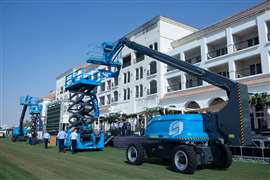South America sees huge growth for cranes
22 August 2011
[1].gif)
For many manufacturers South America, particularly Brazil, represents their biggest growth market. It is not surprising most of them are taking as much advantage as possible.
South America GDP growth is on track to rise 4.5% in 2011 on top of a very strong 5.8% growth performance in 2010, according to IHS Global Insight.
Harald Böhaker at Austria-based loader crane manufacturer Palfinger sees a similar trend. From his point of view 2011 should see growth reaching 5% in Brazil, 6% in Chile, 8% in Argentina and 4% in Peru. He forecasts this level of growth should remain steady for the next four years.
"We are working with the expectation of Palfinger growing at about 15 to 20% per year from 2010 to 2015 in South America. Depending on the country, different market strategies are in place, including expanding our territory and setting up dealers where we are not present, mainly in the north and northeast Brazil."
Brazil is by far the leading construction market in South America, spearheaded by a drive for new infrastructure. Overall, preparation for the World Cup in 2014 and Olympic Games in 2016, combined with Brazil's growing oil sector, are driving a forecast US$ 140.5 billion infrastructure spend by 2020, according to IHS Global Insight.
Even after the excitement of the games has subsided, the market will remain healthy, with construction spending growing 7% per year, buoyed by the energy sector with 62% of investments in the next three years will be in the oil and gas industry, says Scott Hazelton.
Rising sales
According to Wolfgang Beringer at mobile crane manufacturer Liebherr-Werk Ehingen, its sales in Brazil have risen some 60% and the country is now its best export market. Sales include large wheeled mobile cranes like the 1,200 tonne capacity LTM 11200-9.1, as well as big crawler cranes. "But the bestsellers in Brazil are the 90, 220 and 500 capacity cranes," adds Beringer.
A blemish on the outstanding growth rate comes in the form of delays to some infrastructure projects, according to Rene Porta, Sany crane manager in Brazil. He says the Chinese crane manufacturer has sold about 20 large crawler cranes in the 750 and 1,000 tonne capacity ranges into the country, but they are sitting idle in the customers' yards. "Most of them have been delivered but some of the big infrastructure projects have not begun yet. The projects should have started in the second period of 2011, but now we are hearing they will be delayed until the beginning of 2012."
While these higher capacity machines await their turn, Porta says the most popular crawlers in use are 300 tonne capacity models working on general construction.
The rough terrain is also finding many applications and is possibly showing the strongest growth rate of any the crane type the country. "This is truly dictated by the type of work, with lots of large project work: stadiums, refineries. RTs are a very convenient tool for those types of jobs," says Bruce Buchan, Manitowoc senior vice president of sales and marketing for Latin America. "The driver is energy related applications as well as commodities - commodity pricing is very strong."
Porta echoes the view on the RT's success. "In Brazil, we estimate we have had 18 to 20 % growth in the last 12 months. RTs around 55 tonnes are the most popular. RTs have not been used that much in the last 10 years; now they are becoming more and more popular because of the long-term projects we have going."
The truck crane market is also very strong, says Buchan. "We feel a lot of competition there but it really is a strong all terrain market too, the preference of many customers is for ATs and they are expanding their fleets with 4-, 5- and 6-axle machines.
Expanding on the all terrain versus truck crane theme, Porta adds, "ATs are very popular but we have a lot of demand for truck cranes. Truck crane capacity is increasing; once we only had truck cranes up to 70 tonnes capacity but now they are increasing to 100 and 130 tonnes and taking some all terrain crane projects. But all terrains are still very popular, above 220 tonne capacity."
Lupercio Neto, president of Brazil-based rental giant Irga adds that Brazil is increasingly becoming a truck crane market for lower capacity Chinese-manufactured truck cranes up to 70 tonnes capacity. The situation, however, is not affecting rental rates, he says, which remain flat, at the same rate as 2010 across the crane types.
Loading up
Concerning articulated loader cranes, the most common products are the mid-range models says Böhaker, like the Palfinger PK 12500, PK15500, PK 23000 and MD 43607. "The trend is moving to bigger machines, such as PK 32502 up to the PK 100002 in the following years.
For tower cranes, growth is good, "although I wouldn't characterise it as huge," says Buchan. "Our most common model is the Potain MCI85; it's a smaller crane but it is the dominant workhorse in the rental fleets. Some of our long-established dealers are replenishing and replacing their fleets, and that is significant for us," adds Buchan.
Small is good for Liebherr too: the manufacturer presented the 85 EC-B 5 FR.tronic flat top city crane at the SMOPyC exhibition in Spain in April for the first time. While it is manufactured at the Pamplona plant in Spain, the 5 tonne capacity model is aimed at the South American and Asian markets where urban space is at a premium. "A typical problem when working in town and city centres today is that space is extremely limited. A decisive advantage is that the dimensions of all the assemblies of the new 85 EC-B 5 FR.tronic city crane are so compact," says Hans-Martin Frech, Liebherr-Werk Biberach marketing director.
New facilities
Substantial growth has prompted manufacturers to start production in the continent, with newly-built facilities, particularly in Brazil. Manitowoc will build its first Latin American crane factory in Brazil. The new 12,000 square metre plant will be in Passo Fundo, a city in the southern state of Rio Grande do Sul. The initial focus will be the production of mobile hydraulic cranes, which will come off the production line about 15 months after construction begins.
Sany opened an assembly plant in Brazil in March and already produces 200 truck cranes in the 25, 55 and 75 tonne capacity range a year from imported components manufactured in China. Excavators are also assembled there.
The company has also purchased 550,000 square metres of land and will build a new factory to produce all major components. "We are looking to start producing in 2013 and right now we are preparing the land and infrastructure," explains Porta, "We will produce up to 220 tonne all terrain, truck cranes and, probably, rough terrains too. We will also focus on concrete pumps, graders, excavators and rollers to reflect the whole product line here."
Tadano is in the process of establishing a joint venture sales and service company in Brazil. It is being set up with the manufacturer's distributor in the country and will start out as a training and after sales service centre. The idea is to supply superstructures to be mounted on locally produced chassis.
"There are lots of enquires for all cranes in Brazil and surrounding markets. Some customers are requesting complete units, while others are asking for cranes to be mounted on a conventional truck," says Shinichi Iimura, Tadano executive officer, international operations. "We will try to expand the sales of rough and all terrains from Japan and Germany, and another category is the truck mounted crane. Which will probably be a new area for us, but that is not yet specified." The facility is set to open sometime in mid-2011.
Libherr has a new tower crane production facility in Brazil, while Ehingen has doubled its sales and service teams in most of the South American countries and recently inaugurated a new service facility in Chile.
Challenges
While Manitowoc has no plans to design new models specifically for the South American market, it has adapted its machines to local conditions. "We have found so far the customer base here accept cranes that are pretty much specified the way Europeans and North Americans would buy them," says Buchan.
"But we are looking at high altitude engines. As the engines in the AT and RT become more burdened with the Tier IV process, getting them to run at altitude is a challenge. Right now we can still use Tier III in Latin America abut as the Tier IV fuel becomes available we will switch to those engines."
While Brazil is the strongest South American market by far, there is significant growth elsewhere on the continent. "Argentina and Chile are developing very well, in Chile the main application is mining with cranes from 130 to 250 tonnes. Even in Peru we could sell some mobile cranes, worth mentioning is the sale of a 500 tonne LTM 1500-8.1," says Beringer.
"Generally, we see a good market for larger mobile and crawler cranes but we also sold smaller cranes. In Argentina last year the majority of mobile cranes was in the range of 30 to 100 tonnes lifting capacity. Argentina is driven by the petrochemical industry, mining, infrastructure projects as well as wind power." Argentina and Chile are also good markets for used cranes, adds Beringer.
Böhaker at Palfinger says, "We are replacing weak dealers to get a better and stronger market positioning, mainly in southeast and centre-east Brazil, Argentina and Peru. We are looking at educated dealership in pre- and after- sales."
Education is a topical issue for all manufacturers and operating companies as the economy and applications grow. "If you look at the risk overall in the marketplace, I would say it is the human capital," says Nuchan. "Finding skilled workers for our customers, whether they are operators, technicians, electricians or welders, is becoming very difficult in parts of the region. I have talked to some big customers, especially in Chile and Peru, and they are having to expand their recruiting further than they ever did in the past. Some customers are now recruiting in Iberica to find skilled labour."
Buchan adds, "It's a very dynamic labour marketplace. Riggers, operators and engineers are moving from place-to-place pretty quickly right now. We work very closely with companies like Macro to help train. They have to manage their business accordingly, and as fast as they need to get work done they are having to train at the same time."
Another example of the Iberica link comes through MYCSA, a Palfinger, Tadano and Sennebogen distributor for Spain. The company claims to have had 50% of the knuckle boom market in Spain during the boom years of 2007 - 08, amounting to some 1,500 units a year. Once the downturn came, the market dropped to almost zero. In one case, MYCSA bought back 40 trucks with loader cranes attached from a single company and sold them through its used crane division to customers in South America.
Figures
Despite these issues the future of countries beyond Brazil is forecast to be strong. Argentina's construction sector was worth $14.4 billion in 2010, according to IHS Global Insight, which forecasts that the country's total construction spend is forecast to increase at a rate of 3.8% in 2011 and 2012, led by investment in the country's non-residential construction sector.
Construction growth in Chile, meanwhile, is increasing for different reasons. Reconstruction projects from 2010's devastating earthquake in the Atacama region are driving expected 10.8% growth in the country's construction sector this year, according to the Chilean Construction Chamber.
Similarly, strong growth is forecast for Peru's construction sector. The industry is expected to grow by 12% this year, according to the AEM, (Association of Equipment Manufacturers) driven by new builds in the residential housing and commercial sectors.
Even so, there are risks to the region in the short and medium term, mostly related to the world economy, such as further problems in southern Europe, particularly because of close ties between Latin America and Spain, and the possibility of a slowdown in China. Certainly, a double-dip world recession would lead to a drop in commodity prices and demand for the region's exports. The biggest losers in such a scenario would be Venezuela, Ecuador and, to a lesser extent, Colombia, says Hazelton.
An added concern comes from high import duties and taxes duties, mainly in Brazil, says Beringer. "Financing is also a big issue, but we see positive signs in the fact that financing possibilities in Latin America are being extended as international investors become more active there."
Porta's view is not dampened, however. "Sany realises the huge potential for the next 10 years. Our expectation is to grow more than 50% each year. The advantage of the Chinese brand is they have the opportunity to work very fast to seek opportunities and implement improvements." Porta adds, "We hope to be the leader in the market and number one brand in Brazil in the next five years. We are looking at selling 800 units in five years' time across all the ranges."
Beringer is also positive, "We are very confident that the market will continue to stay on a high level, as there is still a high demand in the development of infrastructure and high investments are being made in refineries, pipelines and drilling platforms."






